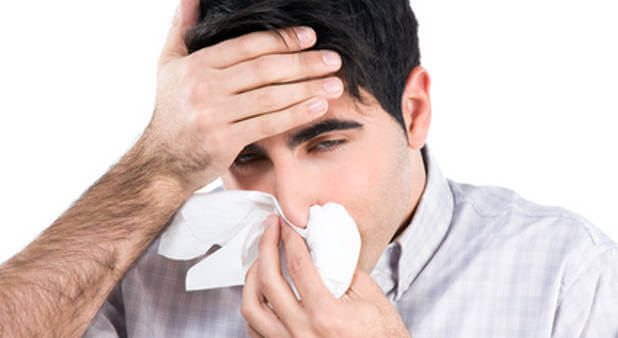For millions of Americans who suffered through record cold and snow during the brutal winter of 2014-15, spring can’t come early enough. But for many of the 40 million in the U.S. with seasonal allergies, the misery index is already rising—with an early spring allergy season shaping up in some regions of the U.S.
On the West Coast and Southwestern United States, allergists are now seeing high levels of pollen—providing an early glimpse of things to come for the rest of the nation in the weeks ahead. Health experts are predicting that unusual drought conditions in some regions and high levels of rainfall and snowmelt in others will produce a bumper crop of pollinating trees and grasses, as well as mold growth.
But specialists also note the severity of allergy season depends not only on total pollen counts, but also on temperatures, precipitation, and the amounts and varieties of flowering plants in certain areas that produce allergic reactions.
“People focus on the highs and lows of pollen counts,” says allergist James Sublett, M.D., president of the American College of Allergy, Asthma and Immunology. “What they don’t realize is that a high total pollen count doesn’t always mean you will have allergy symptoms.
“The pollen from the plant you are allergic to may not be high. The key is to know what you’re allergic to, and how to treat your particular symptoms.”
According to the Centers for Disease Control and Prevention, about 8 percent of Americans suffer from seasonal allergies that cause stuffy and runny noses, watery and itchy eyes, sneezing, and wheezing. Allergies are also the sixth-leading cause of chronic illness in the U.S. with an annual cost in excess of $18 billion, the ACAAI estimates.
But there are things you can do to keep your spring allergy symptoms under control. Among them
1. Keep allergens outdoors. Don’t track pollen and other allergens indoors. Make sure to change clothes after being outdoors, tap your shoes outside your house to knock off any pollen, and wash your hair before getting in bed.
2. Keep your home clean. Allergens are often present on doormats, carpets, furniture, and curtains. Vacuum your house regularly to remove irritants, keep windows closed, run your air conditioning (if you have it), and check bathrooms and kitchens for mold growth, which can exacerbate allergies.
3. Stay indoors during peak hours. Pollen and allergen concentrations tend to peak early in the morning and on dry, hot, and windy days. Limit the time you spend outdoors during these hours so you are outside when it is cooler, less windy, and later in the day.
4. Use a mask. An air-filtering mask help prevent allergic reactions. Some higher-end masks—equipped HEPA filters—can be as effective as over-the-counter remedies.
5. Take antihistamines. Antihistamines can reduce allergic reactions. Among them: Allegra, Benedryl, Dimetane, Claritin, Alavert, Tavist, Chlor-Trimeton, and Zyrtec. Note that taking medicines for spring allergies can cause drowsiness and dry mouth. And if you start taking medicine before the worst symptoms hit, the severity of your reactions may be lessened.
6. Avoid certain fruits and vegetables. If you suffer from seasonal allergies, you may also be more likely to have allergic reactions to certain types of fruits, vegetables, and nuts. For instance, if you are allergic to birch or alder trees, you might have strong reactions to apples, cherries or even celery, apples, or cherries. If you have grass allergies, then tomatoes, potatoes, and peaches may cause you irritation.
7. Allergy shots. Immunotherapy injections can help, if symptoms continue for many months of the year, by boosting the immune system to become more resistant to specific allergens and lessen symptoms. Immunotherapy involves receiving regular injections given in increasing doses. Someone who begins allergy shots in January will typically experience a significant reduction, or elimination, of symptoms by April. Most patients need them once every month or so in the first few years of receiving shots, but some people may eventually be able to discontinue them.
8. New immunotherapy tablets. The Food and Drug Administration approved this form of allergy treatment in 2014. Starting at least three months before allergy season begins, patients dissolve a tablet under the tongue daily, and treatment can continue for as long as three years. Only two allergens (grass and ragweed pollens) can now be treated with this method, but it may be a good option for patients with grass pollen allergy not controlled with medications.
Allergists also point out that certain regions of the U.S. are worse than others, when it comes to allergens. The Asthma and Allergy Foundation of America has compiled a “Spring Allergy Capitals” report card that has identified the 100 U.S. cities with the right mix of factors to be considered the worst places for allergy sufferers.
Louisville ranked number one on the AAFA’s most recent report, followed by Dallas, Richmond, and Birmingham. The rankings are based on the metropolitan area’s pollen score, which reflects recorded pollen/mold spore levels, the duration of the peak spring season, the percentage of people in the area who are affected by those pollens, and allergy medicine use.
Even cities that rank low on the AAFA report—such as Colorado Springs, which placed last at 100—are considered bad for allergies. The point of the ranking, AAFA officials say, is to let allergy sufferers know that they need to take extra precautions if they live in, or are visiting, one of the nation’s “Spring Allergy Capitals.”
For the original article, visit newsmaxhealth.com.















































